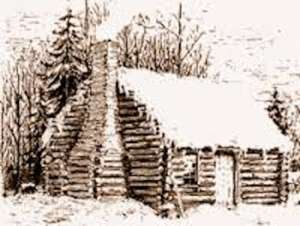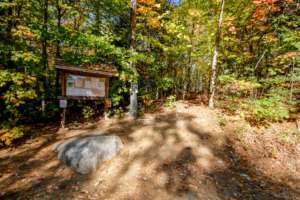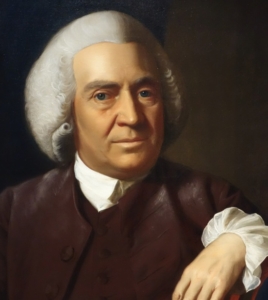Up and down the Kennebec Valley: Early Sidney Settlers
by Mary Grow
Conclusion
Researching former Sidney residents on line, your writer has repeatedly come across a colorful small book entitled Early Sidney, by Chloe B., with a photo of the historic Levi Powers house on the front. The site is bookcreator.com.
Chloe B. mentioned three early settlers she believed gave names to features in the landscape: Samuel Goff (Goff Brook); Philip Snow (Snow Pond, aka Messalonskee Lake); and Samuel Ward, husband of Lois Clark, from Vassalboro (Ward Pond).
Philip Snow and the town of Belgrade
The beginning of the known history of Belgrade began in 1774, when a man named Philip Snow decided to look for new hunting grounds beyond the familiar lands in Sidney. He crossed the lake to the west and built a log cabin about two miles north of what is now Belgrade Depot. After six years of using this as a base for hunting trips, Snow sold his cabin to Joseph Greely. He returned at a later date to settle on the west side of the lake with his wife and nine children. Snow Pond (now Messalonskee Lake) and Mt. Philip (just north of Belgrade Lakes) were both named in his honor.
To finish this longer-than-planned subseries on Sidney’s early residents, your writer will share information about these families, and one more.
* * * * * *
As mentioned in past articles, your writer believes the stream running through Reyolds Forest and into the Kennebec was called first Bog Brook and then Hastings Brook.
Bog Brook could be taken as descriptive. Hastings Brook probably recognizes an early Sidney family whose first members settled on the river road.
Alice Hammond’s history of Sidney has multiple references to Sidney’s Hastings family. They were of British descent; Hammond wrote an ancestor was named John Seaborn Hastings because he was born (in 1732) on ship on the way to Massachusetts.
The first Hastings in Vassalboro, Hammond said, were Mathew (1718-1791), his wife Mary Battle (1720 – 1804), their son Moses (1743-1838) and their eight daughters. About 1770, Mathew bought land “on the north end of the West River Road” from an advertisement in a Boston newspaper.
Henry Kingsbury’s list of early Vassalboro officials, in his Kennebec County history, listed Matthew (with two ts) Hastings as one of the first three selectmen, elected in 1771 and serving 10 years, and as town clerk in 1782 and 1783. When Sidney separated in 1792, Moses Hastings served as a Sidney selectman for the first two years.
Moses was the one who married John Marsh’s daughter Hannah in 1772 and inherited the property that is now the Reynolds Forest Preserve, mentioned last week. According to familysearch, Moses and Hannah had four sons and five daughters between 1774 and 1796, including another Moses (1774 – 1812) and General Mathew (1796 – 1878, grandson of the first Mathew).
Hammond said Moses (1743) succeeded John Marsh as owner of grist mills and sawmills on Hastings Brook. Mathew (1796) was born in Sidney and lived in Calais, Maine, familysearch says. He had 16 children by two marriages.
A comprehensive book on early Calais families by Thelma Eye Brooks (copyright 2002), found on line, says Mathew Hastings served as a Massachusetts militia private in the War of 1812, from Sept. 24 to Nov. 10, 1814. Later he was active in the Maine militia for years, becoming a brigadier general by 1841 – hence his title.
Brooks wrote that General Mathew’s second son by his first wife and first son by his second wife each served in the Civil War and later lived in Sidney. (Other sources provide differing information.)
Gorham Kimball Hastings, born in Calais Feb. 7, 1830, and died in Sidney March 18, 1921, was a second lieutenant in the 26th Maine Infantry and a seaman in the Civil War. In 1880 he represented Sidney in the Maine House of Representatives as a member of the Greenback Party. In 1889, copying his grandfather Moses (1743), he was a Sidney selectman for a year.
Simon Cutter Hastings, born in Calais May 5, 1843, was a corporal in the 21st Maine Infantry. On Sept. 30, 1873, he married Ellen Faught (1845 – 1912, daughter of Athony Faught and Olive Hamlin – see the Aug. 15 article on Sidney’s Faught family).
Simon Hastings served as a Sidney selectman for five years. He died in Portland (where he had been living with his sister, Jennie Tyler) on July 15, 1938, and was buried in the Sibley cemetery with his wife.
* * * * * *
Your writer merely surmises Hastings Brook underwent a name change and became Goff Brook; she has found no proof. She has learned that the Goffs did not come to Sidney until 1829, and that they were mill-owners, two pieces of information supporting the idea the brook was renamed.
Chloe B. wrote that Goff Brook was “likely named for Samuel Goff.”
According to Hammond, the first Goffs in Sidney were two sons of William Francis and Rebecca (Bates) Goff, from Windsor. The older was William Francis Goff, Jr., born in 1805; his brother, Samuel Wesley Goff (1806 – 1871), bought the first family property on Nov. 17, 1829, on Goff Road.
Contemporary maps show Goff Road running north off Dinsmore Road, roughly parallel to West River Road, and dead-ending before it reaches Goff Brook.
Hammond generalized that Goff men tended to earn their livings as “lumbermen, farmers and blacksmiths”; the women she described as homemakers or teachers. She and Kingsbury said that William, Jr., built a shingle mill on the homestead in 1850, “about the last” 19th-century mill built in the town. Kingsbury said it ran for around 20 years; Le Roy Goff owned the property in 1892.
Find a Grave says Samuel married Olive P. Chadbourne (1814 – 1878), in Sidney, on Nov. 10, 1835. They had 12 children, of whom William (born in 1835) and Leroy Sylvester (1850 – 1906; perhaps Kingsbury’s Le Roy?) stayed in Sidney, with Leroy inheriting the family home.
Leroy married Cora Sibley (1864 – 1934), from Passadumkeag, Maine, in Bangor, on Nov. 6, 1886. One source says they had three daughters and five sons, born in Sidney between 1884 and 1903; at least two of their grandsons are listed as keeping the Goff name in Sidney into the 20th century.
One of Sidney’s cemeteries is named Clark/Goff; it has the grave of the senior William Francis Goff, 1782 – 1845 (but not his wife, Rebecca). William Francis, Jr., is not listed as buried there. His brother and sister-in-law, Samuel and Olive, are.
* * * * * *
Philip Snow was probably in what is now Sidney before 1774, but to call him a settler might be misleading. Accounts your writer found describe him as a wandering hunter, who sometimes joined his wife and children living in Sidney.
Snow was born Feb. 18, 1748, most likely in Dunstable, Massachusetts (one source suggests Dunstable, New Hampshire). On June 13, 1772, he married Abigail or Abagail Townsend (born Apr. 17, 1754, in Hopkinton, Massachusetts) in Hallowell.
Evidently the family home was in Sidney, because two sources describe Snow moving, alone, across the big lake in west Sidney to build a log cabin as a hunting base, and thus founding the Town of Belgrade.
One source says Snow was one of several central Maine men who served as guides for Benedict Arnold’s 1775 expedition to Québec.
He sold the cabin after six years and, one source says, “probably” returned to his wife. He spent enough time with her so that when the family later (no specific date) came back to the west – Belgrade – side of the lake, he and Abigail had eight or nine children.
The online source rootsweb lists eight children: Hannah, born March 21, 1773, in Hallowell; Sarah, born Feb. 12, 1774; Abigail, born in 1777; Stephen, born in 1779; Moses, born in 1781; Betsy; Jonathan; and Philip, born in 1787.
Sarah and her younger brothers Stephen, Moses and Philip moved north, with Milo and Charleston (northwest of Bangor) named as destinations. Both parents died in Charleston, Philip in 1850 and, according to one source, Abigail the same year at the age of 102 (your writer found no other source giving her death date).
* * * * * *
An article back in March was partly about Ward Pond, in southern Sidney on the northeast side of Route 27. Your writer surmised the pond was named after one or more of Sidney’s Ward families, but could not – and still cannot — figure out why Chloe B. gave the honor to Samuel who married Lois Clark.
The Sidney map in the 1856 Kennebec County atlas shows several Ward houses southeast, west and northwest of the pond. The 1879 map reproduced in Hammond’s history shows what might be the southeast house still there, with a blacksmith shop beside it, and another Ward dwelling farther north, on the east side of Quaker Road (which runs northish off Route 27, on the east side of the pond).
John Ward owned land in Sidney by 1794. When the first 10 school districts were laid out that year, some of the boundaries Hammond quoted referenced his land, which was evidently several miles from the Kennebec.
John Ward might be the John Ward, Sr., (born in 1733; or June 23, 1735, in Newton, Massachusetts) Kingsbury listed among early settlers in western Sidney, with his son, Deacon William Ward. Find a Grave says in 1757 John Ward, Sr., married Mary Clapp, born Jan. 23, 1738, in Dorchester, Massachusetts, by whom he had four children (but familysearch lists more; see below).
Find a Grave says the couple’s first daughter lived only a year or so. The second daughter, born in 1761, died in 1840 in Ohio. The third daughter, Anna, born in Dorchester in 1769, died in Sidney in 1841, widow of Eleazer Cummings (whose information on line is extraordinarily contradictory; your writer found no reference to Sidney).
John and Mary’s fourth child, according to Find a Grave, was Deacon William Ward (1769 – 1844). Ancestry.com says in 1796, he married Elizabeth Godfrey (1778 – 1868), from Nova Scotia.
None of these Wards was the Samuel mentioned in Chloe B.’s book. He appears on the familysearch website as John and Mary’s seventh child in a list that reads as follows: Clap (1755 – 1755), Mary (1758 -1759), Elizabeth (1760 – Deceased), Mindwell (1761 – 1840), Mindwell (1761 – Deceased), Sarah (1762 – 1806), Samuel (1764 – 1809), Elder William (1768 – 1804), Ann (1769 – 1841) and John, Jr. (1775 – 1823).
Familysearch says Samuel Ward did indeed marry Lois Clark (1769 – 1857), on July 27, 1787 (Chloe B. said 1786). Between 1788 and 1808 they had four daughters and four sons.
Familysearch says their first son, Thomas (1790 – 1867) was born in Vassalboro (because Sidney did not exist until 1792). The other children were born in Sidney. Second son, Samuel, Jr. (1797 – 1882) was blind, familysearch says; he seems not to have married.
BRCA/Seven Lakes Mount Phillip trail
A second landmark honoring Philip Snow is a mountain that has been variously called Mount Philip, Mount Phillips and now Mount Phillip.
Kingsbury wrote that Mount Philip was in the Town of Belgrade, west of Sidney, near the village of Belgrade Mills (now Belgrade Lakes), and that the name honored Snow’s “famous hunting exploits in its vicinity.”
This location has been contradicted repeatedly by newer sources: Mount Philip is not near Belgrade Lakes, in west central Belgrade, but about seven miles north, in the adjoining town of Rome.
According to the Belgrade-based conservation organization the 7 Lakes Alliance, in 2004 the Alliance, “in collaboration with” Great Pond’s Pine Island Camp, acquired 207 acres, including a 1.4-mile loop trail and the mountain’s 755-foot summit.
The website alltrails.com calls the Mount Phillip Loop Trail a “moderately-challenging” 45-minute hike. This and other on-line trail sites recommend it for hiking, birding, views and snowshoeing. Trailhead parking is on the north side of Route 225, a mile and a half east of the junction with Route 27.
(Your writer cannot resist quoting from the first paragraph of Kingsbury’s 1892 chapter on the Town of Rome. He wrote that Rome “is situated twenty miles northwest from Augusta, with which it is connected by a daily stage running to New Sharon. It has seven times as many hills as the eternal city whose name it bears, and granite enough to rebuild the old Roman capital.”)
Main sources:
Hammond, Alice, History of Sidney Maine 1792-1992 (1992).
Kingsbury, Henry D., ed., Illustrated History of Kennebec County Maine 1625-1892 (1892)
Websites, miscellaneous.
Responsible journalism is hard work!
It is also expensive!
If you enjoy reading The Town Line and the good news we bring you each week, would you consider a donation to help us continue the work we’re doing?
The Town Line is a 501(c)(3) nonprofit private foundation, and all donations are tax deductible under the Internal Revenue Service code.
To help, please visit our online donation page or mail a check payable to The Town Line, PO Box 89, South China, ME 04358. Your contribution is appreciated!







Thanks for that interesting history, Mary.
Do you know if Goff Brook is the stream shown on early Plymouth Company maps in the 1600s as Negumkike?
https://www.mainememory.net/record/11977
Thank you